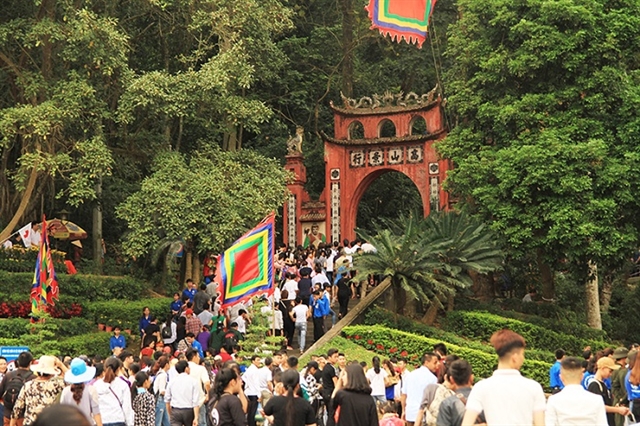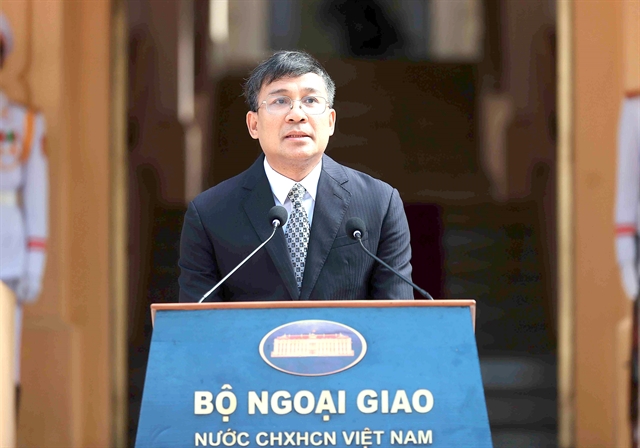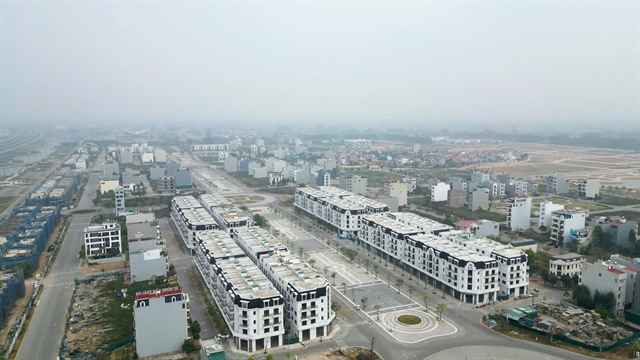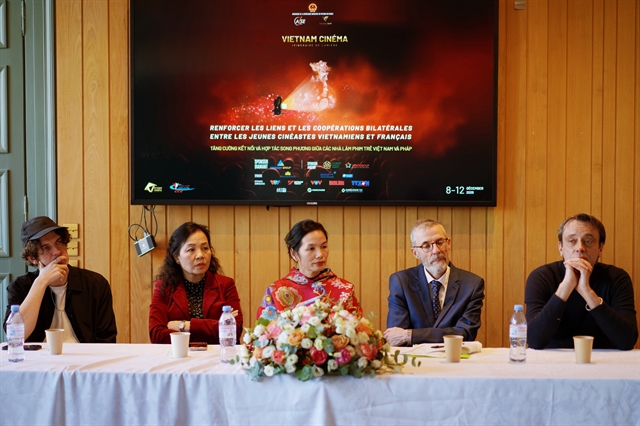 Opinion
Opinion

 |
| Permanent Deputy Minister of Foreign Affairs Nguyễn Minh Vũ. – Photo baochinhphu.vn |
According to Permanent Deputy Minister of Foreign Affairs Nguyễn Minh Vũ, Việt Nam has made significant progress in resolving land border issues with neighbouring countries. On the occasion of the 80th anniversary of Việt Nam’s diplomatic service (August 28, 1945 – 2025), he spoke with the press about the role of diplomacy in safeguarding the nation’s sovereignty and territorial integrity over the past eight decades.
On the occasion of the 80th anniversary of Việt Nam’s diplomatic service (August 28, 1945 – 2025), what role has diplomacy played in safeguarding the nation’s sovereignty and territorial integrity over the past eight decades?
Eighty years ago, on August 28, 1945, the Provisional Government of the Democratic Republic of Việt Nam issued its Declaration of Formation, along with the first unified national cabinet list. At that time, President Hồ Chí Minh concurrently held the position of Minister of Foreign Affairs, marking the first chapter in Việt Nam’s revolutionary diplomacy.
Over the past eight decades, diplomacy has remained one of the three key pillars in Việt Nam’s cause of national construction and defence. The country has skilfully employed peaceful means – such as dialogue, negotiation, international legal instruments and strategic communication – to affirm national legitimacy, foster friendly international relations, seize opportunities and address challenges across historical periods. These efforts have consistently safeguarded national interests.
With firm resolve, determination and tireless negotiation – guided by mutual respect, goodwill and adherence to international law – Việt Nam has completed the delimitation of its entire land border with China, Laos and Cambodia. It has finalised all border demarcation and marker planting with China and Laos and completed 84 per cent of this work with Cambodia. The remaining 16 per cent is currently under negotiation, with priority given to the 6 per cent concerning land swaps under the 2011 Memorandum of Understanding (MoU) framework.
Việt Nam has also signed legal documents with its neighbours defining borders and establishing regulations for border management. These agreements have contributed to building peaceful, stable, friendly and cooperative borders that support sustainable development. Such achievements reinforce Việt Nam’s image as a peace-loving, deeply integrated country with increasing international stature.
In maritime affairs, Việt Nam’s diplomatic corps has taken the lead – working in coordination with relevant ministries and agencies – to define and protect the country’s legitimate rights and interests in accordance with international law, especially the 1982 United Nations Convention on the Law of the Sea (UNCLOS).
Significant achievements include the 1982 agreement on historic waters with Cambodia; the 1997 agreement delimiting the exclusive economic zones (EEZs) and continental shelves between Việt Nam and Thailand; the 2000 agreement with China on delimiting the territorial seas, EEZs and continental shelves in the Gulf of Tonkin; and the 2003 agreement on the delimitation of continental shelves between Việt Nam and Indonesia.
More recently, in 2022, Việt Nam concluded negotiations on EEZ delimitation with Indonesia. In 2024, it formally submitted an extended continental shelf claim beyond 200 nautical miles in the central East Sea (internationally known as the South China Sea) and in 2025, announced new baselines for calculating its territorial sea breadth in the Gulf of Tonkin. These are historic milestones in asserting Việt Nam’s maritime rights and addressing overlapping claims through international legal frameworks.
Furthermore, Việt Nam has promoted bilateral maritime cooperation mechanisms with neighbouring countries. Examples include the 1993 joint oil and gas exploration and exploitation arrangement with Malaysia, and the 2000 fisheries cooperation agreement in the Gulf of Tonkin with China. The country has also participated in international dialogues and cooperation programmes concerning maritime issues.
These mechanisms are not only economically beneficial but also play a strategic role in strengthening trust, maintaining a peaceful and stable regional environment, and creating favourable conditions for the peaceful resolution of maritime disputes in the East Sea.
Now that Việt Nam and its neighbours have completed land border delimitation and largely finished border demarcation, what will be the diplomatic priorities in this area in the coming years?
Going forward, alongside continued negotiations to resolve outstanding issues – including the 16 per cent of the Việt Nam–Cambodia land border that remains undemarcated – Việt Nam’s diplomacy will focus on two strategic priorities in land border management.
First, maintaining a peaceful and stable environment along the borders by ensuring the effective operation of bilateral border management mechanisms. This includes close coordination in managing the land border based on legal documents and agreements already signed with neighbouring countries, while proactively and promptly addressing any incidents on the ground.
Second, promoting development cooperation as a breakthrough approach and foundation for peace and stability. Building on established borders, the diplomatic sector will work closely with border localities and relevant ministries to advance economic diplomacy in line with national and local development needs. This involves improving border gate management, developing border infrastructure and implementing projects to support socio-economic growth, thereby fostering trade, tourism, investment and people-to-people exchanges across the border, while ensuring national defence and security in border areas.
In the context of continuing complex developments in the East Sea, what guiding principles and approaches does Việt Nam’s diplomacy adopt in addressing this issue?
The East Sea holds strategic importance for Việt Nam’s security and development, profoundly affecting regional peace and stability and remains a matter of international concern. To manage these challenges and promote cooperation for peace and development, Việt Nam has consistently advanced efforts on three fronts: political-diplomatic, legal and information and public opinion.
On the political-diplomatic front, Việt Nam adheres to the principle of being resolute and persistent in safeguarding sovereignty, sovereign rights and jurisdiction at sea while maintaining a peaceful and stable environment to facilitate national development and international integration. This approach is reflected in three key directions.
First, persisting in settling disputes through peaceful means based on international law, particularly the 1982 United Nations Convention on the Law of the Sea (UNCLOS).
Second, actively promoting Việt Nam’s position in multilateral mechanisms such as the United Nations and asserting its consistent stance at regional forums including the ASEAN Inter-Parliamentary Assembly (AIPA), ASEAN Regional Forum (ARF) and East Asia Summit (EAS), emphasising that disputes must be resolved peacefully, without the use or threat of force, in accordance with international law, especially UNCLOS.
Third, promoting negotiations and dialogue to resolve outstanding issues and strengthening maritime cooperation with countries in and outside the region to prevent conflict, build trust and seek long-term solutions to the East Sea issue.
On the legal front, Việt Nam consistently pursues peaceful dispute resolution in line with international law, including UNCLOS and has applied this approach in settling maritime delimitation issues with neighbouring states. Looking ahead, Việt Nam will continue to implement the Declaration on the Conduct of Parties in the South China Sea (DOC) and actively participate in developing an effective, substantive Code of Conduct (COC) between ASEAN and China, in line with international law and UNCLOS.
Additionally, Việt Nam will strengthen cooperation with international legal organisations and leading experts to refine its legal dossiers, reinforce its legal basis for maritime claims, and prepare appropriate legal measures if necessary.
On the information and public opinion front, Việt Nam views the defence of maritime sovereignty as the responsibility of the entire political system, armed forces, and the people. The diplomatic service has been and will continue to provide information on the Party and State’s positions regarding maritime issues, affirming Việt Nam’s sovereignty and legitimate rights and countering arguments and actions that violate its sovereignty.
Through these efforts, Việt Nam seeks to convey the message of a peace-loving nation that remains resolute and persistent in safeguarding its sovereignty and legitimate rights, while actively cooperating to promote regional peace, stability and development.
In the field of border and territorial affairs, many experts consider Việt Nam a model of peaceful dispute resolution. What lessons can be drawn from Việt Nam’s experience?
Việt Nam has consistently resolved all border and territorial issues through peaceful means, in accordance with international law, particularly the UN Charter, relevant international legal principles and the law of the sea in maritime disputes. This approach has enabled the country to successfully overcome many challenges in border and territorial negotiations.
The signing and effective implementation of the 1977 Việt Nam–Laos Land Border Treaty and the 1999 Việt Nam–China Land Border Treaty, as well as the completion of land border demarcation with China in 2008 and with Laos in 2007, together with numerous maritime delimitation agreements with neighbouring countries, clearly demonstrate the effectiveness of this approach.
Việt Nam views confidence-building as a crucial foundation for achieving this goal. Therefore, the country has consistently maintained bilateral and multilateral dialogue mechanisms and promoted cooperation in various areas in border regions. These efforts have facilitated the sustainable development of trade, tourism and people-to-people exchanges alongside ensuring security and order in border areas and at sea.
Another key lesson is the need for close coordination between domestic and external efforts, across all levels and sectors, ensuring unity in implementing each specific task in border and territorial management. At the same time, it is essential to link state diplomacy and party-to-party diplomacy with people-to-people diplomacy, mobilising the role of border residents, academic communities and the media.
The peaceful settlement of border and territorial issues and the establishment of today’s border lines are vivid testaments to the wisdom, resilience and stature of Việt Nam’s diplomacy, as well as the unity of all levels of government, sectors, and localities in pursuit of a common goal: protecting the core values of national interests.
In a world of growing uncertainty, Việt Nam’s lessons on respecting international law, adhering to principles of independence, sovereignty and territorial integrity, pursuing peace, stability and development as ultimate goals and using cooperation as a tool remain as relevant as ever. Việt Nam stands ready to share these experiences with international partners in the interest of a more stable and peaceful world. VNS




